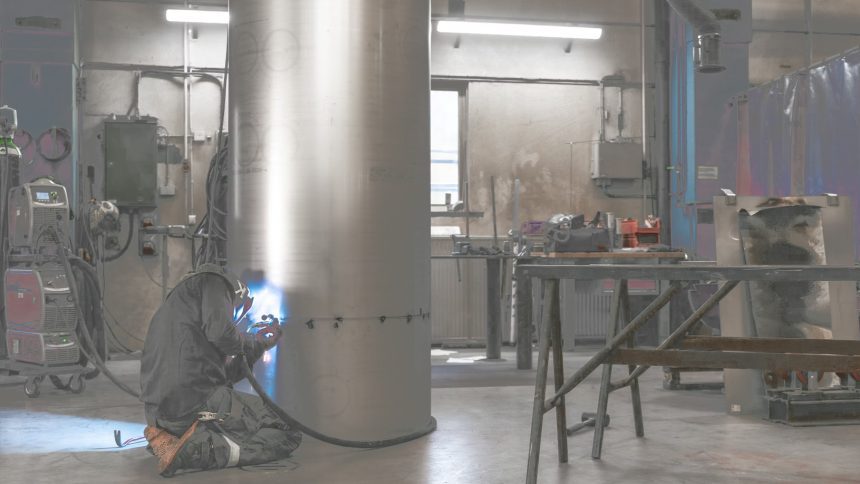Aluminum, an extraordinary and unparalleled metal, boasts a myriad of advantageous attributes that render it a prime choice for diverse projects. Given its exceptional properties, the practice of Tungsten Inert Gas (TIG) welding on aluminum is not an uncommon occurrence.
Aluminum is a difficult material to weld. Here is a guide covering all the major aspects of TIG welding on aluminum.
Welding Town
What’s the Heat Input of TIG Welding on Aluminum?
TIG welding is commonly utilized on aluminum plates, which serve as essential components in various structural applications, including chemical and cryogenics processing industries. However, this alloy is highly sensitive to welding heat input, leading to well-known defects like porosity and solidification cracking.
The heat input in TIG welding is influenced by a combination of welding torch travel speed and welding current, resulting in a range from 0.89 kJ/mm to 5 kJ/mm. For aluminum welding, it is generally recommended to maintain a heat input of around 1-1.2 kJ/mm, which proves sufficient for optimal results.
TIG welders work in a powerful heat environment and must prioritize their safety. However, they also require touch sensitivity and a fair amount of dexterity to ensure precise welding. To protect against the intense heat, TIG welders can use specialized equipment like TIG fingers and invest in high-quality welding gloves. The right gloves provide both heat protection and the necessary dexterity for efficient and safe TIG welding operations.
By being equipped with the proper safety gear and following best practices, TIG welders can effectively tackle aluminum welding challenges and achieve superior weld quality while safeguarding their well-being.
TIG Welding Aluminum Machines
When it comes to welding aluminum, a TIG welder running on AC power is one of the best choices, offering excellent prices and valuable features. The top TIG welding aluminum machines on the market today are known for providing clean starts, smooth arcs, user-friendly settings, and essential functionalities. Here’s a brief overview of these machines:
Lotos TIG/Stick Welder: This welding machine is equipped with features essential for various TIG and stick welding applications, including TIG non-contact arc initiation. It stands out with consistent arc starts and increased reliability compared to conventional HF arc starters. Its easy installation and automatic line power management system make it convenient to use, particularly in job settings with unreliable or dirty power sources.
Forney Easy TIG Welder: An excellent choice for home use, the Forney Easy TIG welder offers reliability at an affordable price point, making it a favorite among users.
Lincoln 210: This multi-process welder caters to the needs of educators, small contractors, and individuals interested in MIG welding. Its push-and-turn digital controls and color display screen facilitate quick and straightforward operation, providing convenience and ease of use.
Miller Multimatic 215: A user-friendly and versatile welder that supports MIG, TIG, and stick welding, making it an ideal tool for skill development. Its color screen features the auto-set elite, simplifying the setup process. The Miller Multimatic 215 is an all-in-one welder that can be connected to 120 to 240-volt input power and is capable of welding up to 3/8 mild steel.
These top-rated TIG welding aluminum machines offer a range of features and capabilities, catering to various needs and skill levels. Whether for professional use, educational purposes, or home projects, these welders provide reliability and performance, making aluminum welding a smooth and efficient process.
TIG Weldability Between Aluminum And Bronze Alloy
Aluminum and its alloys are highly regarded metals due to their excellent corrosion resistance, lightweight nature, and weldability. Despite having lower strength compared to steel, certain aluminum alloys can exhibit mechanical properties similar to steel. The versatility of these alloys allows for various techniques to merge them, making it crucial to understand the properties of bronze alloys.
Due to the high thermal conductivity of aluminum and its alloys, along with rapid solidification of weld pools, these materials are susceptible to profile imperfections during welding. To overcome potential issues like undercutting, inconsistency, insufficient penetration, or fusion, it is essential to employ the correct welding technique and parameters.
One effective approach is using the metal forehand technique. Additionally, utilizing aluminum bronze rod can yield wear-resistant surfaces when deposited on materials such as cast iron, steel, copper, and other metals. By implementing suitable techniques and materials, welders can achieve high-quality results when working with aluminum and its alloys, ensuring reliable and durable welds for various applications.




![12 Different Types of Welding Processes [The Definitive Guide] 6 12 Different Types of Welding Processes [The Definitive Guide]](https://www.021208.com/wp-content/uploads/2025/01/12-Different-Types-of-Welding-Processes-The-Definitive-Guide-150x150.jpg)






